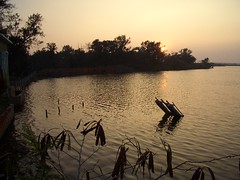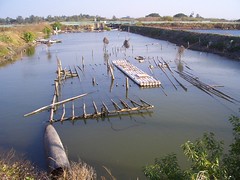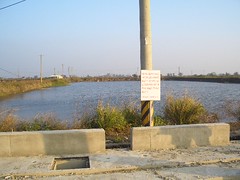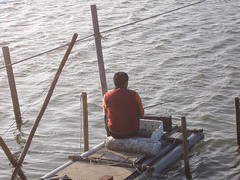
On 27 January 2006, residents of Hsiengong and Luermen townships in Tainan County received a long-awaited first installment of compensation from the EPA. The monthly sum of NT$1814 per person is partly intended to pay for continuing medical treatment of various illnesses caused by toxic pollution at a nearby chemical plant between 1942 and 1982. However, the case has yet to reach a final conclusion, and many are dissatisfied with the outcome of court proceedings to date.
Company’s toxic track record
Anshun plant, situated northwest of Tainan City, has changed hands, names and products several times since its construction by the Japanese in 1942. Originally producing hydrochloric acid, caustic soda, liquid chlorine, and also poison gas for the Japanese navy, by the early 1970s it had become Asia’s biggest producer of the pesticide dichlorodiphenyltrichloroethane (DDT), under the title of state-owned Taiwan Alkali Industrial Corporation (TAIC). After closing in 1982 for economic reasons, it merged with China Petrochemical Development Corporation, which then privatized in 1994, inheriting TAIC and all its property.
Once renowned simply for its vast production volume, news is now spreading that the company site holds some more sinister records. The bottom mud in neighbouring Luermen River has the highest dioxin levels for a river in Taiwan, and one local resident has the highest recorded blood dioxin concentration in the world. In January 2006, the dioxin concentration in one ditch on the site was found to be 64 million TEQ ng/m3 – 64 thousand times the accepted standard.
Dioxin, a byproduct of DDT belonging to a dangerous group of chemicals known as persistent organic pollutants (POPs) or the “dirty dozen”, can result in illnesses affecting the skin, liver, and immune, nervous and reproductive systems. It has also been categorized as carcinogenic to animals, including humans.
In addition to dioxin, soil on the factory site has also been found to contain both DDT and methyl-mercury (CH3Hg+) . DDT is known to affect the nervous system and cause reproductive problems, and is also believed to be carcinogenic, while methyl-mercury causes a range of illnesses including impaired neurological development and severe disabilities in the children of women exposed to it. The horror of methyl-mercury poisoning was first demonstrated in 1956, with the discovery in Japan of what soon became known as Minamata disease .
Locals left in ignorance of peril
For decades, residents of the townships near the Anshun factory have farmed and caught fish and shellfish in the reservoir and ponds surrounding the factory, unaware that what they were eating and selling was poisoned. However, not everyone was oblivious to the danger.

Fish farming equipment in a contaminated pond adjacent to the fenced-off reservoir. Confidential documents show that the Ministry of Economic Affairs (MOEA) warned TAIC in 1982 that mercury concentrations in fish caught in the reservoir (used by TAIC as a toxic waste dump) exceeded safe levels for human consumption. Yet this was not brought to public attention, nor did it result in any attempt to prevent the further spread of pollution, or the consumption of fish harvested in contaminated areas.
It is also believed that Tainan City Government’s Environmental Protection Bureau (EPB), and the Environmental Protection Agency (EPA) neglected their respective supervisory and investigative duties. It was, in fact, purely by chance that the EPB discovered the seriousness of the dioxin pollution in 2001. The Bureau had commissioned National Cheng Kung University to study the blood dioxin concentration of people living near each of the nation’s 12 incinerators, through which it emerged that residents of Hsiengong and Luermen townships had unusually high dioxin levels in their blood. It was then established that this was directly related to their proximity to the China Petrochemical plant.
With so many potentially liable, and because of the length of time that has passed since the pollution occurred, the case is taking a long time to reach a final conclusion. In July 2005, the Executive Yuan promised NT$1.3 billion (US$41 million) compensation for affected residents, but it has taken six months for the first small portion of this to reach victims.
One major complication relates to ownership of the plant. Kaohsiung City High Administrative Court has held China Petrochemical responsible and ordered the company to pay the compensation fees. However, China Petrochemical is presently appealing on the grounds that the pollution occurred under state-owned TAIC, and therefore the government should bear responsibility for the clean-up.
The amount of compensation is also a bone of contention. The monthly sum of NT$1,814 per person is intended to pay for continuing medical treatment of various illnesses, including cancer, as well as social welfare and living expenses. Many regard it as disproportionate to the extent of damage caused to the health and livelihoods of local residents, taking little account of past medical costs and other losses, and failing to discriminate between the varying needs and severity of illness among the population.
Further contamination still a threat
As for control of the pollution and the ongoing clean-up of the factory grounds, some of the most polluted soil has been removed to a concrete store on the site, and China Petrochemical has installed and begun to use equipment to treat the chemicals. But no urgent action is being taken to deal with the remaining pollution, which may spread beyond the factory boundaries during heavy rainfall. Also, birds and other animals continue to nest and feed there, and in one place, a large pipe runs under the walkway separating one off-limits pond from Luermen River, allowing water, silt and fish to move freely between the two.

Please don't fish here, it might be polluted.
Still only crude physical barriers hinder human entry to the most seriously polluted areas, and there is little enforcement of the 2005 ban on fishing. In December 2005, the only indications of danger were a few sparsely distributed signs from Tainan City Government suggesting a “likelihood” or “unconfirmed level” of pollution. According to local researchers, these measures are insufficient to discourage some residents, who do not understand how seriously to take such warnings, particularly when large, healthy-looking fish and crabs can be seen in the water.
Fishing on Luermen River, meters away from
a pipe leading to a contaminated pond. Despite the high instance of illness in the local population, those who have eaten fish from these waters all their lives find it hard to comprehend the invisible threat.
Wild at Heart and groups in Tainan continue to seek proper recognition and treatment of the TAIC case.
Note: A version of this piece is featured in the Taipei Times as a letter to the editor.